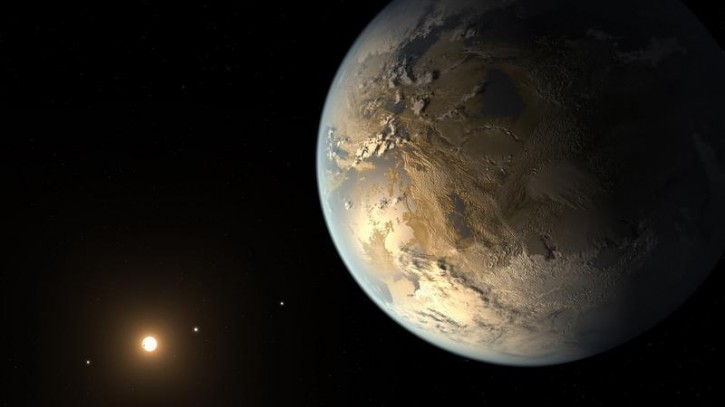 Moffett Field, CA – For the first time, scientists have found an Earth-sized world orbiting in a life-friendly zone around a distant star.
Moffett Field, CA – For the first time, scientists have found an Earth-sized world orbiting in a life-friendly zone around a distant star.
Subscribe to our Daily Roundup Email
The discovery, announced on Thursday, is the closest scientists have come so far to finding a true Earth twin. The star, known as Kepler-186 and located about 500 light years away in the constellation Cygnus, is smaller and redder than the sun.
The star’s outermost planet, designated Kepler-186f, receives about one-third the radiation from its parent star as Earth gets from the sun, meaning that high noon on this world would be roughly akin to Earth an hour before sunset, said astronomer Thomas Barclay, with NASA’s Ames Research Center in Moffett Field, California.
The planet is the right distance from its host star for water — if any exists — to be liquid on the surface, a condition that scientists suspect is necessary for life.
“This planet is an Earth cousin, not an Earth twin,” said Barclay, who is among a team of scientists reporting on the discovery in the journal Science this week.
NASA launched its Kepler space telescope in 2009 to search about 150,000 target stars for signs of any planets passing by, or transiting, relative to the telescope’s point of view. Kepler was sidelined by a positioning system failure last year.
Analysis of archived Kepler data continues. From Kepler’s observational perch, a planet about the size and location of Earth orbiting a sun-like star would blot out only about 80 to 100 photons out of every million as it transits.
The pattern is repeated every 365 days and at least three transits would be needed to rule out other possibilities, so the search takes time.
“It’s very challenging to find Earth analogs,” Barclay said. “Most candidates don’t pan out, but things change as we get more measurements.”
Scientists don’t know anything about the atmosphere of Kepler-186f, but it will be a target for future telescopes that can scan for telltale chemicals that may be linked to life.
“This planet is in the habitable zone, but that’s doesn’t mean it is habitable,” Barclay said.
So far, scientists have found nearly 1,800 planets beyond the solar system.
“The past year has seen a lot of progress in the search for Earth-like planets. Kepler-168f is significant because it is the first exoplanet that is the same temperature and is (almost) the same size as Earth,” astronomer David Charbonneau, with the Harvard-Smithsonian Center for Astrophysics, wrote in an email.
“For me the impact is to prove that yes, such planets really do exist,” Charbonneau said. “Now we can point to a star and say, “There lies an Earth-like planet.'”

That planet is 500 light years away, meaning that the star around which that planet is orbiting gave off the light we are seeing today 500 years ago, back in the early 1500’s. In those days, the Rema, the Maharal and R’ Yosef Karo were walking the Earth.
What does chazal say about the possibility of intelligent on other planets? Will we have the geulah by being transported to such another planet and get away from all the anti Semitism on this earth? Does intelligent life on other planets have a Torah?
Or are we the only sentient being in the universe?? Are other sentient beings called malachim, Seraphin, Ofaanim? Shaidim?What does the Zohar say about other planets and life there?
Intelligent answers please. If you can cite authority , all the better.
Next year in Kepler-186, right?
I read in a sefer, i believe it was R Arye Kaplan that we either have a mesorah or chazal say that only those on earth have bechira. Therefore even if there is life on other planets they would be like malachim without bechira and just be ovdaibHashem.